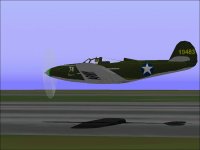aleatorylamp
Charter Member
Hello Ivan,
Don´t worry, I know the vertical figures you mentioned are estimates.
I suppose it wasn´t absolutely necessary to make the changes, but I thought it would
be a good idea to update my CoG, as it was 1.8 inches too low and 4.44 inches too far aft.
As I said, there weren´t any complications with the model shift or texturing re-mapping.
Although I can always scrap the changes and revert to the previous build, there doesn´t
seem to be much point because it´s more accurate now than before.
P.S. If the Datum line stands at 3 inches ahead of the spinner, and the 30 ft 2 inches is the length of the plane, it would be totally absurd to suppose that the plane length goes from a place in the air infront of the spinner, to the rudder-end at the back.
...Unless the Datum line is where it is for a specific reason: Would that be because it includes the short barrel of the 37 mm cannon? Holy Cow, this is going round in circles!
There is a .pdf document about how this plane was built,
http://legendsintheirowntime.com/LiT.../P39_draft.pdf
originally published in the May, 1943 issue, Volume 42, number5, of Aviation magazine, published by McGraw Hill. It has a diagram on page 4 where the length includes the short barrel.
Well... once we know what´s right, we can always shrink the whole model again, improvements and all included - so it´s not really worrying.
Cheers,
Aleatorylamp
Don´t worry, I know the vertical figures you mentioned are estimates.
I suppose it wasn´t absolutely necessary to make the changes, but I thought it would
be a good idea to update my CoG, as it was 1.8 inches too low and 4.44 inches too far aft.
As I said, there weren´t any complications with the model shift or texturing re-mapping.
Although I can always scrap the changes and revert to the previous build, there doesn´t
seem to be much point because it´s more accurate now than before.
P.S. If the Datum line stands at 3 inches ahead of the spinner, and the 30 ft 2 inches is the length of the plane, it would be totally absurd to suppose that the plane length goes from a place in the air infront of the spinner, to the rudder-end at the back.
...Unless the Datum line is where it is for a specific reason: Would that be because it includes the short barrel of the 37 mm cannon? Holy Cow, this is going round in circles!
There is a .pdf document about how this plane was built,
http://legendsintheirowntime.com/LiT.../P39_draft.pdf
originally published in the May, 1943 issue, Volume 42, number5, of Aviation magazine, published by McGraw Hill. It has a diagram on page 4 where the length includes the short barrel.
Well... once we know what´s right, we can always shrink the whole model again, improvements and all included - so it´s not really worrying.
Cheers,
Aleatorylamp

















